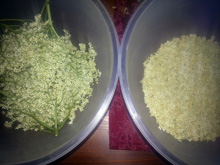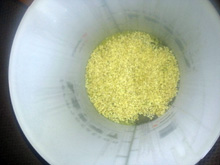My Elderflower Champagne Making Attempt #1
 You may recall that last year I missed my window of opportunity to make elderflower champagne what with college and work, although I did manage to harvest the elderberries later in the year to make elderberry liquor of which I still have half a bottle!
You may recall that last year I missed my window of opportunity to make elderflower champagne what with college and work, although I did manage to harvest the elderberries later in the year to make elderberry liquor of which I still have half a bottle!
This year life has begun to reach a balance so I have kept an eager eye on my elderflower tree and also on Twitter which is great for reminding me to do stuff!
So it is that today I managed to begin my first batch of elderflower champagne – fingers crossed eh?
I decided to follow Hugh Fearnley Whittingstalls’ recipe.

I also researched quite a few different recipes and took some of the readers’ comments and tips into account.
Hopefully as I pass them on here they may help you get creating your very own FREE summer party champagne!
What You need:
- A 7 litre bucket min
- 15 Flowering heads of elderflower
 4 lemons – juice and grated rind
4 lemons – juice and grated rind- 700g sugar
- 2 tablespoons White Wine Vinegar – I used Aspalls
- You may later need A pinch of dried yeast – see below for suggested type of yeast.
Notes:
 I have read many differing views on the best time to pick your elderflowers- morning or later in the afternoon.. but all agree that it must be a warm sunny day – I picked my first batch at around 6pm on a hot afternoon – there were puffs of pollen coming off them as I picked them and as this is what your looking for I considered it a good sign- guess we’ll see..
I have read many differing views on the best time to pick your elderflowers- morning or later in the afternoon.. but all agree that it must be a warm sunny day – I picked my first batch at around 6pm on a hot afternoon – there were puffs of pollen coming off them as I picked them and as this is what your looking for I considered it a good sign- guess we’ll see..- I gently ran my fingernails over the flower stems to detach the flowers from the stem – it took me about an hour and a half so get comfy!
- Note that the stems and leaves are toxic – ” Separate the flowers from the stalks, trying to remove as much of the stems as you can (a few are fine, but too many can be toxic).
TOP TIP:
Since writing this blog I got a top tip from expert forager Fraser Christian who recommended to:”rub the flower heads in a circular motion between cupped hands”..
The Recipe and method that I Intend to follow can be found here:
http://www.channel4.com/4food/recipes/chefs/hugh-fearnley-whittingstall/elderflower-champagne-recipe#comments-top
Tips & Suggestions:
From the comments of Channel4.com Recipes Page:
-
 To avoid explosions, use strong bottles and strong seals.
To avoid explosions, use strong bottles and strong seals. - It’s ok to use coke bottles/supermarket water bottles – I would pay attention to how strong they feel though-see above.
- Let the gas out every day
- Using plastic bottles reduces risk of injury IF a bottle does explode
- ” The trick is not to over fill them, and then as you are screwing the top on to squash them a little to expel as much air as you can. Then as the secondary fermentation kicks in, it produces co2 which pushes the bottle back into shape and hopeful there is still enough gas to make it fizzy!”
- Water should be warm to hot(around 40 degreesC) when adding the flower petals
- Leave some space in the bottle for the gas – Let out the gas DAILY!!!
- “If unsure, just stick to plastic…but not Robinson bottles…they are not designed to take pressure…try fizzy drinks bottles which are designed to hold liquids under pressure.”
- After 2 days, if no foam/bubbles at all then add the yeast as described.
- With the yeast, it’s probably best to stir the potion every day and that should keep from getting mouldy.
- baker’s yeast should work fine
- champagne yeast made the drink very alcoholic
- Last year I added strawberry cordial which gave good results – much safer to try this way – you can buy good quality cordial from supermarkets and probably get more flavour for your money than buying fresh strawberries. You can also experiment by adding other concoctions when bottling – try adding creme de cassis for a Kir Royale; or white rum if you want to blow your head off.
I suggest you read through the channel 4 comments to get an idea of what other people have experienced, the above are just my favourites 🙂
Here’s to bolly darlings! x



